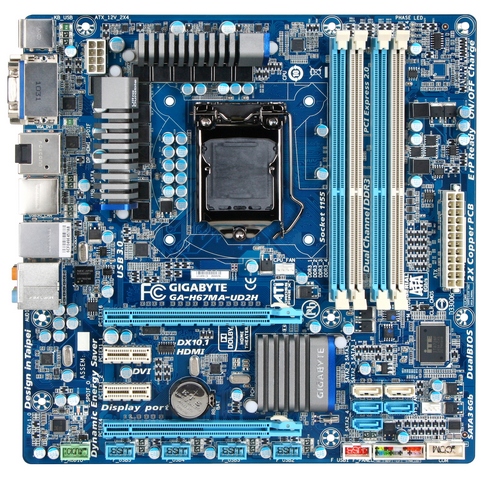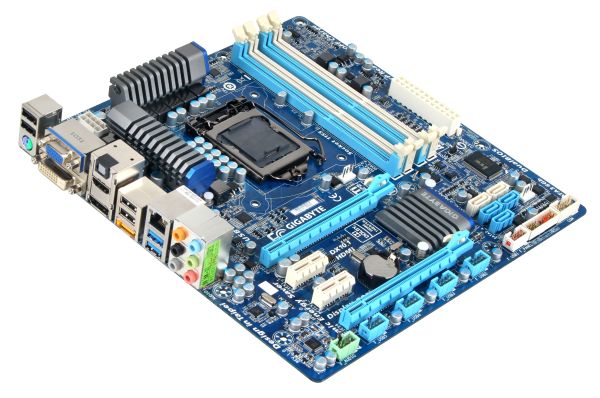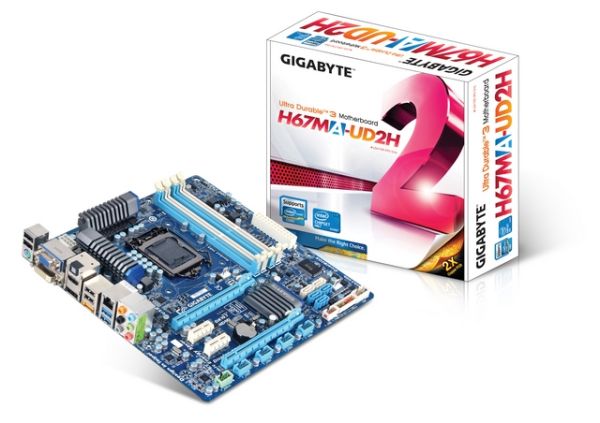H67 – A Triumvirate of Tantalizing Technology
by Ian Cutress on March 27, 2011 6:25 PM EST- Posted in
- Motherboards
- Sandy Bridge
- H67
Overview
The Gigabyte H67MA-UD2H is technically one of sixteen (!) H67 products that Gigabyte have listed on their website. Due to the issue regarding Intel and the chipset recall, Gigabyte have re-released all their boards with the new B3 stepping, and modified their name to match. So the H67MA-UD2H we are testing here is the equivalent of the H67MA-UD2H-B3, but in reality they are the same motherboard, and perform the same, apart from the minor chipset error changed. We expect the UD2H-B3 version to retail at the same as well - $125.
The UD2H has a similar issue to the other two boards tested here today, in that while it states in the BIOS that under single thread loads, the processor should invoke its turbo mode from 33x multiplier base to 37x. In reality it stays for most (98%+) of the time at the 36x multiplier, and very rarely hits 37x, even for short periods of time. I was initially told by ASRock that this is an Intel specification, and it does seem that way. As a result, I can only conclude that by buying a H67 board, consumers are losing that last turbo boosted multiplier under single thread environments. Tsk.
After testing the motherboard, it was a mixed bag of joy and disappointment. On the one hand, the UD2H was the only board out of the three H67 we test here that allowed some form of CPU Overclocking. At first glance in the BIOS, I thought it was better than expected given some of the options (it looked like I could set the CPU to the max turbo multiplier for 100% of the time), but delving deeper I discovered this was not the issue. The 3D performance wasn’t stellar, and the motherboard only has two fan headers on board, meaning my Corsair H50 could only have both fans rotating with an additional 3-pin to molex connector. The design is also a little different…
Visual Inspection
Gigabyte has taken a different tack to ASRock and ECS is our little H67 combined product review – the layout of the board is different (PCIe x4 instead of a PCI) for a start. The SATA ports are all further into the board, and the RAM slots are further away from the 24-pin power connector, leaving a relatively large gap on the board.

With the SATA ports further into the center of the board, and also angled 180° compared to previous manifestations I have encountered, it makes it a little trickier to fit cables in when the board is in a case and a dual slot GPU is present. The PCIe configuration is x16, x1, x1, x4 (electrical), and thus does away with the PCI slots seen on the other boards. Technically these boards do not support Crossfire, and I attempted to fit two GPUs into the board for testing. However, my 5850s are long, dual slot GPUs, and obscure the SATA ports which prevent me testing. Perhaps two short, single slot cards would fit, but unfortunately I have none available to test with.
Another point of interest is the board color – Gigabyte are known for their black and blue boards. But as seen in my review of the P67A-UD4, Gigabyte was veering towards a purely black scheme, as it apparently helps overclocking, according to Gigabyte. As H67 is not a CPU-OC chipset, Gigabyte may have forgone the 10¢ of color and passed the savings on to the consumer. Possibly.
Along the bottom are a plethora of USB headers, but no fan headers. In fact, this board is somewhat lacking fan headers – there is one for the CPU, which is oddly south of the CPU socket, and another next to the SATA ports. Trying to fit a Corsair H50 required some deft placing of the cooler or a fan extension lead, and the second fan required a 3-pin to molex connector.
While no legacy floppy drive connector on board, the PS/2 port in here, along with four USB 2.0 ports, two USB 3.0 ports, the four standard H67 video outputs (D-Sub, DVI-D, HDMI and DisplayPort), a SPDIF_OUT port, an eSATA 3Gb/s port, and the standard Realtek audio inputs and outputs. While there is not a Clear CMOS button, the onboard systems are quite handy at moving into a bootable mode when unbootable settings are chosen.













56 Comments
View All Comments
james.jwb - Sunday, March 27, 2011 - link
"However, I remember the time when I was a scrimping student. I wanted high gaming performance at the lowest cost – if Sandy Bridge was out then, and I was specifically after the Sandy Bridge platform over anything AMD, then a H67 with an i3-2100 and the biggest graphics card I could afford would be a viable option."When I was in this position, i'd go for the cheapest CPU and overclock it so it was faster than anything on the market. I'd be surprised if this wasn't the norm for people on a tight budget.
IanCutress - Sunday, March 27, 2011 - link
My argument mainly for my comment is that the CPU is becoming less of a factor for gaming, thus shifting the focus away from a CPU OC to a large GPU. It used to be the case that the CPU made a large difference as well, but it my mind it's not that much of an issue with a strong default CPU speed and cores available. Nevertheless, the AMD + cheap tri/quad core is on the other side of the coin.Ian
slickr - Monday, March 28, 2011 - link
Intel mobos are crap. Only for overclocking and only for graphics, where is the middle?And they are too expensive, hopefully AMD wipes the floor with them with their new Buldozer platform.
Jeffs0418 - Sunday, May 22, 2016 - link
Here we are 5 years later and...Y'know I was ready to move on from my Athlon 64 x2 5000+/AM2 platform(which I liked but was marginal for modern gaming). I was stoked for a nice capable FX4100/Bulldozer platform. But after reading disappointing reviews I ended up with a Core i3 2120/Sandy Bridge and a H61 mobo. Currently running a Core i5 2500(non-k) massaged a bit to 3.9GHz on all cores with aftermarket cooling on P67 mobo. Never have used Intel integrated graphics so I couldn't care less about that. But I am glad I didn't go with Bulldozer and am comfortable enough with my current setup even now that I'm in no hurry to upgrade.omelet - Sunday, March 27, 2011 - link
Wouldn't someone wanting SB gaming on a budget be more likely to want an H61? You can get such a board from ASRock for like 60 bucks. That's $60 more you'd be able to spend on the GPU, and you'd still have every feature you need. The only real performance difference is that there's no SATA 6Gbps, but budget gamers don't have drives that need that anyway.yzkbug - Sunday, March 27, 2011 - link
Totally agree. I’m looking for a good, reliable, budget-priced motherboard for my new HTPC. Would love to see a comparison review of H61 motherboards, especially the power comparison numbers.Taft12 - Sunday, March 27, 2011 - link
I'd need to know at what point the 6 PCIE lanes on H61 begins to get in the way of the GPUs performance. Someone will surely do the testing to show us in the near future. Noticeable on, say, a 6850? Or do we need a much higher-end GPU for a bottlenect?DanNeely - Sunday, March 27, 2011 - link
The GPU would still be running on the 16 lanes from the CPU. You just have 2 less lanes for 2ndary slots and onboard devices. I don't think it's likely to be an issue except in that you're much less likely to get a second x4 slot (1/11 vs 6/16 on newegg), and the 1 H61 board that does it has legacy PCI slots for the other 2 spaces, while 5/6 H67 boards have at least 1 1x slot as well.omelet - Sunday, March 27, 2011 - link
This is very confusing. All the boards claim to have x16 slots, but they can't possibly run at x16 if none of the boards on the table even have 16 lanes. A P67 running two cards would have to run each at 4x, or even lower if there are any x1 slots on the board (as there are on most boards).It might be explained as being an x16 slot running at a lower speed, except for the fact that P67 and P55 both specify that they can run two cards at x8/x8, which can only mean that they run the x16 slots at 8 lanes each when you have two cards plugged in. That should also be impossible according to the table.
Other sources I've found on the internet seem to imply that the x16 slot on the H61 runs at full x16 speed. I think perhaps we just need some clarification on what the values on the table here mean.
ajp_anton - Sunday, March 27, 2011 - link
There are two sources for PCIe lanes. The CPUs all have x16 (only for graphics), the rest (what is shown in the table) come from the motherboard chip (H67 etc).